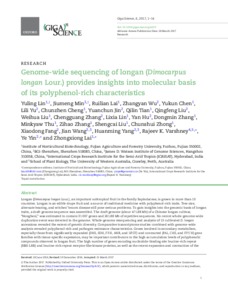Genome-wide sequencing of longan (Dimocarpus longan Lour.) provides insights into molecular basis of its polyphenol-rich characteristics
Abstract
Longan (Dimocarpus longan Lour.), an important subtropical fruit in the family Sapindaceae, is grown in more than 10 countries. Longan is an edible drupe fruit and a source of traditional medicine with polyphenol-rich traits. Tree size, alternate bearing, and witches' broom disease still pose serious problems. To gain insights into the genomic basis of longan traits, a draft genome sequence was assembled. The draft genome (about 471.88 Mb) of a Chinese longan cultivar, “Honghezi,” was estimated to contain 31 007 genes and 261.88 Mb of repetitive sequences. No recent whole-genome-wide duplication event was detected in the genome. Whole-genome resequencing and analysis of 13 cultivated D. longan accessions revealed the extent of genetic diversity. Comparative transcriptome studies combined with genome-wide analysis revealed polyphenol-rich and pathogen resistance characteristics. Genes involved in secondary metabolism, especially those from significantly expanded (DHS, SDH, F3΄H, ANR, and UFGT) and contracted (PAL, CHS, and F3΄5΄H) gene families with tissue-specific expression, may be important contributors to the high accumulation levels of polyphenolic compounds observed in longan fruit. The high number of genes encoding nucleotide-binding site leucine-rich repeat (NBS-LRR) and leucine-rich repeat receptor-like kinase proteins, as well as the recent expansion and contraction of the NBS-LRR family, suggested a genomic basis for resistance to insects, fungus, and bacteria in this fruit tree. These data provide insights into the evolution and diversity of the longan genome. The comparative genomic and transcriptome analyses provided information about longan-specific traits, particularly genes involved in its polyphenol-rich and pathogen resistance characteristics

